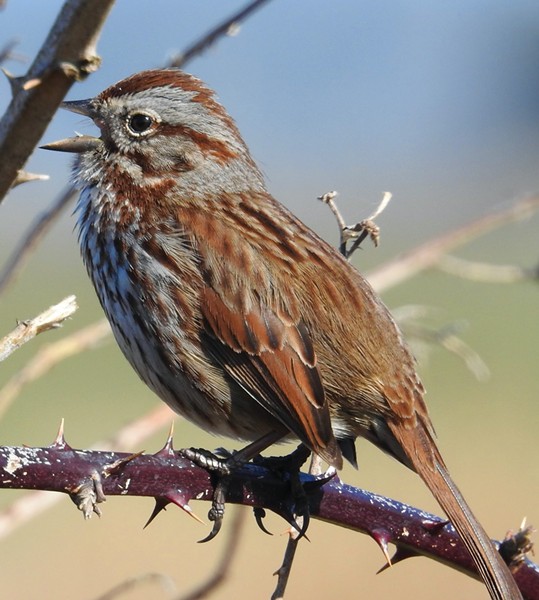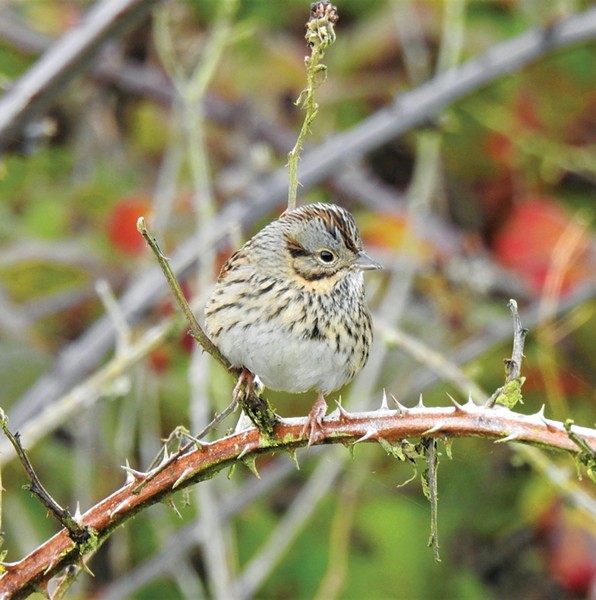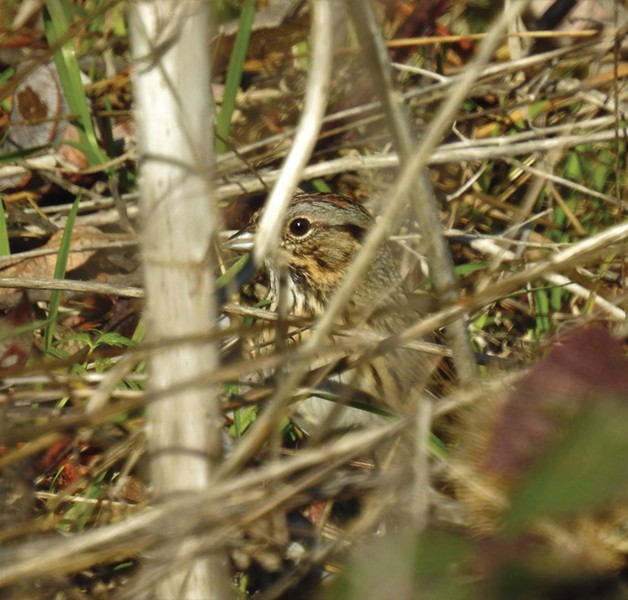Sparrows, in my opinion, get a bum rap.
Few species give birders — even expert ones — more ID trouble. They're small and typically some shade of brown, hence their nickname "LBBs" (little brown birds). They favor dense brush or tall grass, occasionally making short, low flights before dropping out of sight again. Their markings are seldom flashy; sometimes a single spot or stripe is all that distinguishes one species from another.
And yet sparrows can be among the most rewarding birds to get to know. Unlocking the secrets of their unique traits is akin to mastering a foreign language. One day you're struggling to conjugate a verb and the next you rattle off a whole sentence without even thinking about it. With a little practice, you can be fluent in sparrow, too.
Humboldt County has a dozen or so sparrow species that are year-round or regular winter residents. They like the grassy pastures of the Arcata Bottoms, the tangle of vegetation along the Hik'shari and Hammond trails, and myriad other places that provide cover and plenty of seeds on which to forage. There are also rare vagrants — most recently clay-colored sparrows, American tree and Harris's sparrows — whose visits set the birding community aflutter. But let's focus on two locals: the song sparrow and the Lincoln's sparrow.
I have to confess that the bashful Lincoln's is one of my favorite birds. It's always a good day when I spot Melospiza lincolnii peering out through the brambles or perching briefly on a twig before vanishing the minute I reach for my camera. I feel a kinship to its shy ways and cautious approach to the world. It may take some extra effort, but it's a beautiful little bird once you get acquainted.
It also happens to be one of the more challenging sparrows to identify — most of my early Lincoln's IDs were probably song sparrows, their more common cousins. It's easy enough to confuse the two: Both are streaky, gray-brown birds that enjoy brushy habitat and tend to show up singly or in pairs, not in large flocks like, say, a white-crowned sparrow.
Any good field guide will tell you the song sparrow is a long-tailed, boldly marked passerine with a chunky bill and heavily streaked breast with a central breast spot. The Lincoln's, by contrast, has a daintier bill and a buffy malar stripe — that "mustache" mark under the eye — plus a buffy wash across the breast covered in fine streaking. Its rusty cap feathers often stand up to form a little crest. Easy-peasy, right?
Well, no. There's nothing as consistent as the inconsistency in sparrow markings. Song sparrows, especially young ones, can show a lot of buffiness and not much breast streaking. Lincoln's can be more coarsely streaked and appear to have no crest at all — and your bird may not sit still long enough for you to zero in on that malar stripe.
So here are my own field notes, completely subjective and somewhat anthropomorphic, based on years of inexpert observation. The song sparrow is the diva of the sparrow family, a total extrovert. Everything about it is bold: its markings, its behavior and its voice. It'll look you right in the eye before hopping up to the top of a fencepost and belting out the latest version of its love song, of which there are countless variations — it's not named Melospiza melodia for nothing. If your LBB poses for photos, even changing position to show you its best side, it's a song sparrow.
Lincoln's, on the other hand, is an introvert. You might hear one first, a buzzy szeet from deep in the brambles. And oftentimes that's all you'll get from this secretive sparrow. But if you wait patiently, one might come mincing out to take a peek at you, though it won't be easy to see — it prefers to observe you through a screen of shrubbery, making a clear photograph almost impossible.
Everything about a Lincoln's is more restrained. Whereas a song sparrow's streaks might have been slapped on with a paintbrush, the Lincoln's are sketched in fine pencil. It wears its crisp buff, olive and gray plumage like a camo jacket from an army surplus store, the better to melt into its surroundings. There's little that's bold about this bird but it's chock-full of understated charm.
It's a curious trick of nature that two members of the same species — in the same genus, even — can differ so greatly. But life is brimming with infinite variety. Every bird, and everyone, brings something irreplaceable and lovely to the world we live in.
Here in Humboldt, song sparrows live year-round, their joie de vivre on display during all four (well, three) seasons. Lincoln's sparrows are winter residents, showing up around mid-September and departing for their breeding grounds in late spring. So, keep an eye out for them for a few more weeks, and then again in the fall when the first leaves begin to change color and the sky is filled with migrating birds. But look low, not high. And be patient. They're worth the wait.
Sarah Hobart (she/her) is a freelance writer based in Humboldt County.



Comments